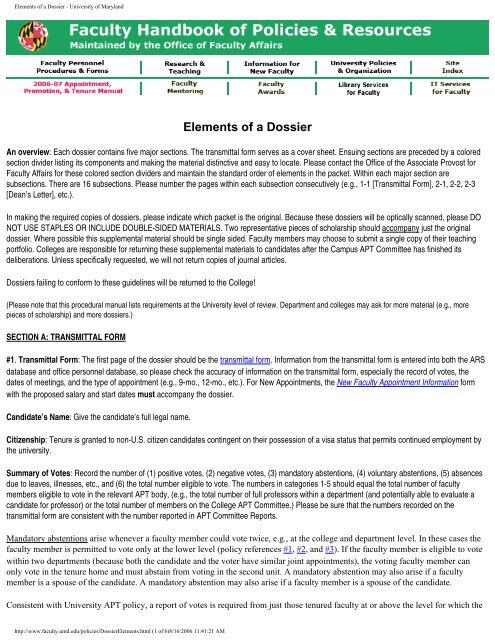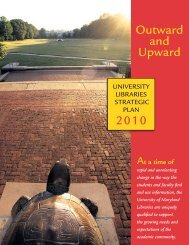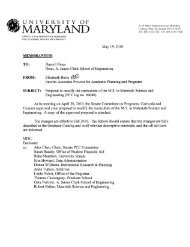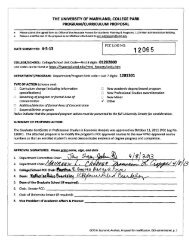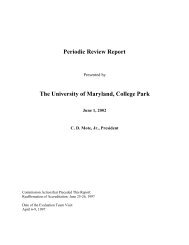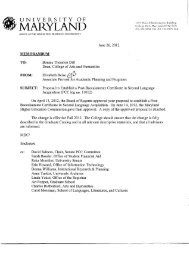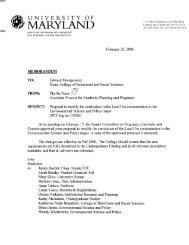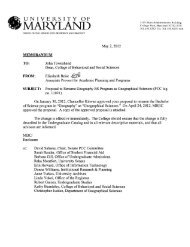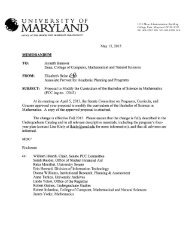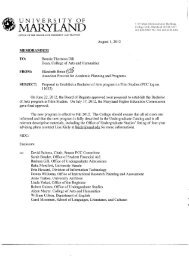Elements of a Dossier - University of Maryland - Office of the Provost
Elements of a Dossier - University of Maryland - Office of the Provost
Elements of a Dossier - University of Maryland - Office of the Provost
You also want an ePaper? Increase the reach of your titles
YUMPU automatically turns print PDFs into web optimized ePapers that Google loves.
<strong>Elements</strong> <strong>of</strong> a <strong>Dossier</strong> - <strong>University</strong> <strong>of</strong> <strong>Maryland</strong><br />
<strong>Elements</strong> <strong>of</strong> a <strong>Dossier</strong><br />
An overview: Each dossier contains five major sections. The transmittal form serves as a cover sheet. Ensuing sections are preceded by a colored<br />
section divider listing its components and making <strong>the</strong> material distinctive and easy to locate. Please contact <strong>the</strong> <strong>Office</strong> <strong>of</strong> <strong>the</strong> Associate <strong>Provost</strong> for<br />
Faculty Affairs for <strong>the</strong>se colored section dividers and maintain <strong>the</strong> standard order <strong>of</strong> elements in <strong>the</strong> packet. Within each major section are<br />
subsections. There are 16 subsections. Please number <strong>the</strong> pages within each subsection consecutively (e.g., 1-1 [Transmittal Form], 2-1, 2-2, 2-3<br />
[Dean’s Letter], etc.).<br />
In making <strong>the</strong> required copies <strong>of</strong> dossiers, please indicate which packet is <strong>the</strong> original. Because <strong>the</strong>se dossiers will be optically scanned, please DO<br />
NOT USE STAPLES OR INCLUDE DOUBLE-SIDED MATERIALS. Two representative pieces <strong>of</strong> scholarship should accompany just <strong>the</strong> original<br />
dossier. Where possible this supplemental material should be single sided. Faculty members may choose to submit a single copy <strong>of</strong> <strong>the</strong>ir teaching<br />
portfolio. Colleges are responsible for returning <strong>the</strong>se supplemental materials to candidates after <strong>the</strong> Campus APT Committee has finished its<br />
deliberations. Unless specifically requested, we will not return copies <strong>of</strong> journal articles.<br />
<strong>Dossier</strong>s failing to conform to <strong>the</strong>se guidelines will be returned to <strong>the</strong> College!<br />
(Please note that this procedural manual lists requirements at <strong>the</strong> <strong>University</strong> level <strong>of</strong> review. Department and colleges may ask for more material (e.g., more<br />
pieces <strong>of</strong> scholarship) and more dossiers.)<br />
SECTION A: TRANSMITTAL FORM<br />
#1. Transmittal Form: The first page <strong>of</strong> <strong>the</strong> dossier should be <strong>the</strong> transmittal form. Information from <strong>the</strong> transmittal form is entered into both <strong>the</strong> ARS<br />
database and <strong>of</strong>fice personnel database, so please check <strong>the</strong> accuracy <strong>of</strong> information on <strong>the</strong> transmittal form, especially <strong>the</strong> record <strong>of</strong> votes, <strong>the</strong><br />
dates <strong>of</strong> meetings, and <strong>the</strong> type <strong>of</strong> appointment (e.g., 9-mo., 12-mo., etc.). For New Appointments, <strong>the</strong> New Faculty Appointment Information form<br />
with <strong>the</strong> proposed salary and start dates must accompany <strong>the</strong> dossier.<br />
Candidate’s Name: Give <strong>the</strong> candidate’s full legal name.<br />
Citizenship: Tenure is granted to non-U.S. citizen candidates contingent on <strong>the</strong>ir possession <strong>of</strong> a visa status that permits continued employment by<br />
<strong>the</strong> university.<br />
Summary <strong>of</strong> Votes: Record <strong>the</strong> number <strong>of</strong> (1) positive votes, (2) negative votes, (3) mandatory abstentions, (4) voluntary abstentions, (5) absences<br />
due to leaves, illnesses, etc., and (6) <strong>the</strong> total number eligible to vote. The numbers in categories 1-5 should equal <strong>the</strong> total number <strong>of</strong> faculty<br />
members eligible to vote in <strong>the</strong> relevant APT body, (e.g., <strong>the</strong> total number <strong>of</strong> full pr<strong>of</strong>essors within a department (and potentially able to evaluate a<br />
candidate for pr<strong>of</strong>essor) or <strong>the</strong> total number <strong>of</strong> members on <strong>the</strong> College APT Committee.) Please be sure that <strong>the</strong> numbers recorded on <strong>the</strong><br />
transmittal form are consistent with <strong>the</strong> number reported in APT Committee Reports.<br />
Mandatory abstentions arise whenever a faculty member could vote twice, e.g., at <strong>the</strong> college and department level. In <strong>the</strong>se cases <strong>the</strong><br />
faculty member is permitted to vote only at <strong>the</strong> lower level (policy references #1, #2, and #3). If <strong>the</strong> faculty member is eligible to vote<br />
within two departments (because both <strong>the</strong> candidate and <strong>the</strong> voter have similar joint appointments), <strong>the</strong> voting faculty member can<br />
only vote in <strong>the</strong> tenure home and must abstain from voting in <strong>the</strong> second unit. A mandatory abstention may also arise if a faculty<br />
member is a spouse <strong>of</strong> <strong>the</strong> candidate. A mandatory abstention may also arise if a faculty member is a spouse <strong>of</strong> <strong>the</strong> candidate.<br />
Consistent with <strong>University</strong> APT policy, a report <strong>of</strong> votes is required from just those tenured faculty at or above <strong>the</strong> level for which <strong>the</strong><br />
http://www.faculty.umd.edu/policies/<strong>Dossier</strong><strong>Elements</strong>.html (1 <strong>of</strong> 6)8/16/2006 11:41:21 AM
<strong>Elements</strong> <strong>of</strong> a <strong>Dossier</strong> - <strong>University</strong> <strong>of</strong> <strong>Maryland</strong><br />
candidate is being reviewed (policy reference). Hence, even though a unit’s Plan <strong>of</strong> Organization may allow votes from faculty below<br />
<strong>the</strong> level to which <strong>the</strong> candidate aspires, or from non-tenured faculty members, those votes should not be recorded on <strong>the</strong> Transmittal<br />
Form or any o<strong>the</strong>r part <strong>of</strong> <strong>the</strong> dossier.<br />
Secondary Unit: If a candidate has a permanent joint appointment in a unit with eligible voters, record <strong>the</strong> votes <strong>of</strong> <strong>the</strong> secondary unit and <strong>the</strong><br />
recommendations <strong>of</strong> <strong>the</strong> unit’s administrator. If <strong>the</strong> appointment is in a different college from <strong>the</strong> tenure home, <strong>the</strong> vote <strong>of</strong> <strong>the</strong> College APT<br />
Committee and <strong>the</strong> Dean should also be recorded.<br />
SECTION B: EVALUATIVE STATEMENTS<br />
#2. Dean's Letter: This letter should state <strong>the</strong> Dean’s personal assessment <strong>of</strong> <strong>the</strong> reasons <strong>the</strong> candidate merits or does not merit<br />
promotion (policy reference).<br />
In evaluating <strong>the</strong> candidate, <strong>the</strong> letter should contain an honest and balanced assessment <strong>of</strong> <strong>the</strong> candidate’s scholarship, teaching,<br />
mentoring, and service, and a clearly stated recommendation. If this recommendation differs from that <strong>of</strong> <strong>the</strong> Department APT<br />
Committee, College APT Committee, or <strong>the</strong> Department Chair, <strong>the</strong> reasons underlying <strong>the</strong> dissent should be explained. Please pay<br />
careful attention to negative votes and try to explain <strong>the</strong> reasons for <strong>the</strong>se votes. Additionally, <strong>the</strong> Dean has a unique “local”<br />
perspective <strong>of</strong> importance to campuswide decisions. The Dean can provide a context for evaluating <strong>the</strong> candidate through<br />
characterizing <strong>the</strong> strengths <strong>of</strong> <strong>the</strong> department, its role in <strong>the</strong> college, and <strong>the</strong> role <strong>of</strong> <strong>the</strong> candidate in enhancing <strong>the</strong> excellence <strong>of</strong> <strong>the</strong><br />
department. Because colleges differ in <strong>the</strong>ir mission, <strong>the</strong> letter should also discuss <strong>the</strong> expectations <strong>of</strong> <strong>the</strong> college and department for<br />
promotion. If <strong>the</strong> candidate’s original appointment was based on expectations that differ significantly from commonly accepted<br />
criteria, <strong>the</strong> Dean should discuss <strong>the</strong> source and nature <strong>of</strong> <strong>the</strong> criteria on which <strong>the</strong> candidate is to be evaluated.<br />
#3. College APT Committee Report: This report should include <strong>the</strong> date <strong>of</strong> <strong>the</strong> meeting and <strong>the</strong> names <strong>of</strong> committee members.<br />
The report should include a statement <strong>of</strong> <strong>the</strong> exact vote and <strong>the</strong> reasons for <strong>the</strong> recommendation (policy reference) and it should<br />
address <strong>the</strong> same areas as <strong>the</strong> Department APT report described in #5.<br />
When <strong>the</strong> vote is not unanimous, it is helpful if <strong>the</strong> report discusses <strong>the</strong> reasons for <strong>the</strong> negative votes or <strong>the</strong> abstentions. If <strong>the</strong><br />
assessment differs from <strong>the</strong> department vote, please explain why.<br />
#4. Department Chair's Letter: The letter should contain <strong>the</strong> Chair’s independent evaluation <strong>of</strong> <strong>the</strong> candidate’s teaching, scholarship,<br />
mentoring, and service, and should make a clear recommendation supported by <strong>the</strong> reasons for it (policy references #1 and #2).<br />
As with <strong>the</strong> Dean’s letter, <strong>the</strong> <strong>University</strong> APT Committee finds <strong>the</strong> Chair’s letter to be most useful when it places <strong>the</strong> performance <strong>of</strong><br />
<strong>the</strong> candidate in <strong>the</strong> context <strong>of</strong> <strong>the</strong> department or discipline and comments on <strong>the</strong> APT Committee’s report. Committees also look for<br />
<strong>the</strong> Chair’s interpretation <strong>of</strong> <strong>the</strong> information about <strong>the</strong> candidate, not simply a reiteration <strong>of</strong> information. They seek an honest and<br />
balanced assessment <strong>of</strong> <strong>the</strong> candidate’s scholarship, teaching, mentoring, and service, and a clearly stated recommendation. If this<br />
recommendation differs from that <strong>of</strong> a Department APT Committee, it is helpful to explain <strong>the</strong> reasons . The Chair should also attempt<br />
to explain reasons for negative votes when <strong>the</strong>y are known.<br />
#5a. Department APT Committee Report: (policy reference) The report <strong>of</strong> <strong>the</strong> Departmental APT Committee has two clearly<br />
separable parts. The first part 5(a) describing <strong>the</strong> decision meeting, is ordinarily written by <strong>the</strong> Chair <strong>of</strong> <strong>the</strong> APT Committee or his or<br />
her designee and reports <strong>the</strong> discussions and <strong>the</strong> exact vote as well as any department rules about <strong>the</strong> number <strong>of</strong> votes required for a<br />
positive recommendation. The report should contain <strong>the</strong> meeting date and be signed by its author. The second part 5(b), <strong>the</strong> evaluative<br />
report, is <strong>of</strong>ten written by an initial review subcommittee (whose members should be identified). It summarizes and evaluates <strong>the</strong><br />
candidate’s research, service, mentoring, and teaching contributions in light <strong>of</strong> <strong>the</strong> standards <strong>of</strong> <strong>the</strong> department and <strong>of</strong> <strong>the</strong> discipline.<br />
Nei<strong>the</strong>r report is shown to <strong>the</strong> candidate. These letters along with <strong>the</strong> Department Chair’s letter, are transmitted to <strong>the</strong> higher levels <strong>of</strong><br />
review (policy reference).<br />
It is helpful to consider <strong>the</strong> following questions when preparing <strong>the</strong> evaluative report:<br />
a. What are <strong>the</strong> standards and expectations <strong>of</strong> <strong>the</strong> department or <strong>the</strong> discipline with respect to <strong>the</strong> candidate and how are <strong>the</strong>y<br />
http://www.faculty.umd.edu/policies/<strong>Dossier</strong><strong>Elements</strong>.html (2 <strong>of</strong> 6)8/16/2006 11:41:21 AM
<strong>Elements</strong> <strong>of</strong> a <strong>Dossier</strong> - <strong>University</strong> <strong>of</strong> <strong>Maryland</strong><br />
measured?<br />
b. What are <strong>the</strong> candidate’s major contributions in <strong>the</strong>se areas? Why are <strong>the</strong>se contributions important?<br />
c. Has <strong>the</strong> candidate met or surpassed <strong>the</strong> unit’s standards and expectations?<br />
d. What evidence supports <strong>the</strong> review committee’s evaluation?<br />
This information is particularly helpful in areas <strong>of</strong> <strong>the</strong> <strong>University</strong> like <strong>the</strong> performing arts and <strong>Maryland</strong> Cooperative Extension with<br />
distinctive expectations for promotion. It is important to consider <strong>the</strong> audience to whom this report will be addressed, which includes<br />
faculty and administrators outside <strong>the</strong> unit.<br />
For additional information, please see a set <strong>of</strong> important suggestions for evaluating faculty performance.<br />
The third part 5(c) (Optional) Members <strong>of</strong> <strong>the</strong> Department APT Committee who do not think that <strong>the</strong> APT Committee Report<br />
adequately represents <strong>the</strong>ir views may write a signed minority APT report that will become part <strong>of</strong> <strong>the</strong> dossier (policy reference)<br />
#6. Summary Statement <strong>of</strong> Pr<strong>of</strong>essional Achievements: (policy reference) This summary is designed to insure that committees have<br />
correct and complete information about <strong>the</strong> candidate on which to base <strong>the</strong>ir evaluation and to explain to higher-level committees <strong>the</strong><br />
discipline and how <strong>the</strong> candidate fits within it. The summary, written by <strong>the</strong> department APT Committee or its representative, is a<br />
factual statement <strong>of</strong> <strong>the</strong> candidate’s accomplishments in <strong>the</strong> areas <strong>of</strong> research, scholarship, or creative activity; teaching, mentoring,<br />
and advising; and service. It is an internal statement not to be mailed to external reviewers. The Summary Statement should place <strong>the</strong><br />
candidate’s accomplishments in research, scholarship, extension activities and/or artistic performance in <strong>the</strong> context <strong>of</strong> <strong>the</strong> broader<br />
discipline and <strong>the</strong> candidate’s pr<strong>of</strong>essional achievements in service and teaching in <strong>the</strong> context <strong>of</strong> <strong>the</strong> responsibilities <strong>of</strong> <strong>the</strong> unit, <strong>the</strong><br />
college and <strong>the</strong> university and <strong>the</strong> greater community. It should be a neutral description; no evaluation <strong>of</strong> <strong>the</strong> candidate’s work<br />
should be included. The candidate must be shown <strong>the</strong> Summary Statement at least 2 weeks before <strong>the</strong> unit deliberates <strong>the</strong> candidate’s<br />
case. Candidates must certify that <strong>the</strong>y have seen it, and must be allowed to draft a rejoinder before it is used by <strong>the</strong> department APT<br />
Committee as <strong>the</strong> basis for its discussion and vote. Thus <strong>the</strong> date on this report should predate <strong>the</strong> meeting on which <strong>the</strong> case is<br />
decided. When <strong>the</strong>re is a rejoinder, <strong>the</strong> summary must acknowledge receipt and consideration <strong>of</strong> <strong>the</strong> rejoinder. To facilitate this<br />
procedure, units may wish to inform candidates in advance <strong>of</strong> <strong>the</strong> deadlines for seeing <strong>the</strong> Summary Statement and for return <strong>of</strong> <strong>the</strong><br />
signed Statement with any rejoinder.<br />
SECTION C: PERSONAL STATEMENT<br />
#7. Format <strong>of</strong> a Curriculum Vitae: The faculty member’s curriculum vitae should be signed and dated to certify that it is accurate<br />
and current. The c.v. should be prepared no later than <strong>the</strong> beginning <strong>of</strong> <strong>the</strong> academic year in which <strong>the</strong> candidate is reviewed and<br />
should be included in each request for external evaluation. The c.v. that is read by <strong>the</strong> Department APT Committee and sent to<br />
external referees is <strong>the</strong> <strong>of</strong>ficial c.v. for <strong>the</strong> candidate. If <strong>the</strong>re are subsequent changes, <strong>the</strong> first level administrator should forward a<br />
memo containing <strong>the</strong>se changes to higher levels <strong>of</strong> review. Thus <strong>the</strong> date on <strong>the</strong> c.v. must predate <strong>the</strong> date <strong>of</strong> <strong>the</strong> voting meeting and<br />
<strong>the</strong> committee must not change <strong>the</strong> c.v. during <strong>the</strong> course <strong>of</strong> <strong>the</strong> review!! The c. v. should present a portrait <strong>of</strong> <strong>the</strong> candidate’s<br />
accomplishments in as concise a manner as possible. To aid <strong>the</strong> review committees, <strong>the</strong> c.v. should carefully follow <strong>the</strong> <strong>University</strong>'s c.<br />
v. format.<br />
#8. Reputation <strong>of</strong> Publication Outlets: The department should provide an appraisal <strong>of</strong> <strong>the</strong> reputations <strong>of</strong> <strong>the</strong> journals, presses, and o<strong>the</strong>r<br />
outlets (e.g., <strong>the</strong>aters, exhibits, etc.) for <strong>the</strong> candidate’s scholarship/creative activity. Indicate whe<strong>the</strong>r peer review is required, and when possible, <strong>the</strong><br />
rate <strong>of</strong> acceptance to <strong>the</strong> journal or o<strong>the</strong>r medium. Departments should develop a standard, stable, credible method <strong>of</strong> rating journals and should<br />
present <strong>the</strong>se ratings. Often departments or disciplines rate <strong>the</strong> journals for <strong>the</strong>ir impact.<br />
One <strong>of</strong> <strong>the</strong> most helpful ways <strong>of</strong> evaluating <strong>the</strong> reputation <strong>of</strong> journals is a chart that lists <strong>the</strong> journals in <strong>the</strong> candidate’s field in rank<br />
order and indicates <strong>the</strong> articles appearing in journals <strong>of</strong> a given rank, e.g., two in <strong>the</strong> top ranked journal, two in <strong>the</strong> second ranked<br />
journal, etc. The listing can be confined to just those journals in which <strong>the</strong> candidate published.<br />
#9. Candidate's Personal Statement: (policy references #1 and #2) This statement provides candidates with <strong>the</strong> opportunity to make<br />
a case for <strong>the</strong>ir promotion based on a demonstrated record <strong>of</strong> achievement. The statement ordinarily indicates <strong>the</strong> importance <strong>of</strong> <strong>the</strong><br />
questions addressed in <strong>the</strong> candidate’s field <strong>of</strong> research or scholarship, <strong>the</strong> progress made in addressing <strong>the</strong>se questions and <strong>the</strong><br />
directions <strong>of</strong> future research. These statements should be relatively short, less than 3-4 pages, and directed toward readers who may<br />
http://www.faculty.umd.edu/policies/<strong>Dossier</strong><strong>Elements</strong>.html (3 <strong>of</strong> 6)8/16/2006 11:41:21 AM
<strong>Elements</strong> <strong>of</strong> a <strong>Dossier</strong> - <strong>University</strong> <strong>of</strong> <strong>Maryland</strong><br />
not be specialists in <strong>the</strong> candidate’s field. (Viewing examples <strong>of</strong> past personal statements may assist faculty in preparing <strong>the</strong>ir own<br />
statements. The personal statement should be signed and dated. The personal statement should be prepared no later than <strong>the</strong> beginning<br />
<strong>of</strong> <strong>the</strong> academic year in which <strong>the</strong> candidate is reviewed and should be included in each request for external evaluation (policy<br />
reference).<br />
SECTION D: EXTERNAL EVALUATIONS<br />
#10. Log <strong>of</strong> Letters <strong>of</strong> Evaluation: The committee shall solicit letters <strong>of</strong> evaluation from six or more widely recognized authorities in<br />
<strong>the</strong> field, chosen from a list that shall include individuals nominated by <strong>the</strong> candidate. At least three letters and at most one-half <strong>of</strong> <strong>the</strong><br />
requested letters shall be from persons nominated by <strong>the</strong> candidate (policy reference).<br />
The committee must include a list <strong>of</strong> all <strong>the</strong> evaluators to whom a letter was sent, even if <strong>the</strong> reviewers do not reply or refuse to write. The refusals<br />
should be part <strong>of</strong> <strong>the</strong> dossier. Include dates letters were requested, and <strong>the</strong> dates when ei<strong>the</strong>r <strong>the</strong> evaluation was received or <strong>the</strong> reviewer refused to<br />
write a review. The table below provides a sample <strong>of</strong> a candidate's letter log. A template for <strong>the</strong> letter log is available in Word. The order <strong>of</strong> letters in<br />
<strong>the</strong> dossier should correspond to <strong>the</strong> order <strong>of</strong> letters in <strong>the</strong> log and <strong>the</strong> letters should be grouped by requestor (candidate or review unit). Because <strong>the</strong><br />
first level APT Committee should have access to <strong>the</strong> same external letters as subsequent levels <strong>of</strong> review, late arriving letters should NOT be<br />
included in <strong>the</strong> dossier nor used for deliberations. If additional letters were solicited by <strong>the</strong> committee to determine <strong>the</strong> role <strong>of</strong> <strong>the</strong> candidate in<br />
collaborative research, <strong>the</strong> letter soliciting <strong>the</strong> input and <strong>the</strong> responses should appear following <strong>the</strong> evaluative section <strong>of</strong> <strong>the</strong> <strong>the</strong> First Level APT<br />
Committee Report. They do not belong in this section.<br />
Referee Affiliation Date Requested Date Replied<br />
Candidate's Choice<br />
Jane Doe Stanford 9/1/06 9/10/06/ Declined<br />
Unit's Choice<br />
John Brown Harvard 9/1/06 9/28/06<br />
#11. Credentials <strong>of</strong> External Evaluators: The credentials <strong>of</strong> each external evaluator should be provided in a paragraph. Do not include c.v.s <strong>of</strong><br />
<strong>the</strong> evaluators.<br />
It is important to justify <strong>the</strong> choices <strong>of</strong> evaluators and to indicate <strong>the</strong> type and quality <strong>of</strong> <strong>the</strong> institution or program with which <strong>the</strong><br />
evaluator is associated.<br />
#12. Sample Letter Used to Solicit External Evaluations: (See two sample letters to external evaluators) The letter used to solicit<br />
external evaluations, usually sent by <strong>the</strong> Chair <strong>of</strong> <strong>the</strong> Department APT Committee, should indicate <strong>the</strong> criteria for promotion, and should include <strong>the</strong><br />
candidate's c.v. and personal statement, and a list <strong>of</strong> scholarly and teaching materials being sent to <strong>the</strong> evaluator. (The unit should provide expectations<br />
to candidates about <strong>the</strong> amount <strong>of</strong> materials reviewers should be reasonably asked to evaluate.) The letter should be neutral, asking for an honest<br />
evaluation ra<strong>the</strong>r than for support for <strong>the</strong> faculty member’s promotion. The letter should ask <strong>the</strong> evaluator to comment on:<br />
●<br />
●<br />
●<br />
●<br />
<strong>the</strong> candidate's ranking among his or her pr<strong>of</strong>essional peers (or cohort).<br />
<strong>the</strong> candidates chances for promotion and where appropriate, tenure, in <strong>the</strong> evaluator's department, a key element in <strong>the</strong> evaluation.<br />
<strong>the</strong> impact <strong>of</strong> <strong>the</strong> candidate's work on <strong>the</strong> field.<br />
<strong>the</strong> quality <strong>of</strong> <strong>the</strong> candidate's teaching. Departments have <strong>the</strong> option <strong>of</strong> sending teaching dossiers including syllabi, examinations, and o<strong>the</strong>r<br />
instructional material to external reviewers for <strong>the</strong>ir evaluation. Reviewers may be asked to comment on <strong>the</strong> scope and currency <strong>of</strong> <strong>the</strong><br />
instructional materials, and <strong>the</strong>ir appropriateness to <strong>the</strong> discipline and to <strong>the</strong> level <strong>of</strong> <strong>the</strong> course.<br />
#13. Responses <strong>of</strong> External Evaluators: The Chair <strong>of</strong> <strong>the</strong> First Level APT Committee should receive suggestions <strong>of</strong> potential<br />
reviewers from <strong>the</strong> candidate. Then <strong>the</strong> committee should select from that list and choose <strong>the</strong>ir own referees. The committee should<br />
solicit <strong>the</strong> external evaluations well in advance <strong>of</strong> <strong>the</strong>ir deadline. Committees should request a minimum <strong>of</strong> six responses from<br />
external evaluators (outside UMCP), at least three but no more than half <strong>of</strong> <strong>the</strong> referees shall be chosen by <strong>the</strong> candidate (policy<br />
reference). Only letters that arrive for timely consideration before <strong>the</strong> vote <strong>of</strong> <strong>the</strong> first-level unit should be included in <strong>the</strong> dossier.<br />
Should an insufficient number <strong>of</strong> letters be received, <strong>the</strong> case may still go forward. However, units should be aware that <strong>the</strong> absence <strong>of</strong><br />
http://www.faculty.umd.edu/policies/<strong>Dossier</strong><strong>Elements</strong>.html (4 <strong>of</strong> 6)8/16/2006 11:41:21 AM
<strong>Elements</strong> <strong>of</strong> a <strong>Dossier</strong> - <strong>University</strong> <strong>of</strong> <strong>Maryland</strong><br />
<strong>the</strong> requisite number <strong>of</strong> letters may weaken <strong>the</strong> case for <strong>the</strong> candidate. Although <strong>the</strong> contents <strong>of</strong> <strong>the</strong> letters are to be shared with<br />
eligible voters at each level <strong>of</strong> review, <strong>the</strong>se letters are highly confidential and should not be shared with <strong>the</strong> candidate or o<strong>the</strong>rs who<br />
will not be voting on or evaluating <strong>the</strong> candidate for promotion.<br />
The following procedures should be followed in presenting letters:<br />
●<br />
●<br />
●<br />
All letters received in response to solicitation must be included in <strong>the</strong>ir entirety if <strong>the</strong> letters arrive for timely consideration by <strong>the</strong> first level <strong>of</strong><br />
review.<br />
Letters in a foreign language must be accompanied by an English translation.<br />
Indicate clearly on each letter whe<strong>the</strong>r <strong>the</strong> evaluator was selected by <strong>the</strong> candidate or committee.<br />
Sometimes <strong>the</strong> candidate and <strong>the</strong> APT Committees choose <strong>the</strong> same referees. IF <strong>the</strong> candidate and <strong>the</strong> committee compile independent<br />
lists <strong>of</strong> referees, <strong>the</strong> department may wish to label as its own <strong>the</strong> referees who appear on both lists.<br />
It is strongly recommended that committees and candidates take into account <strong>the</strong> following issues in selecting <strong>the</strong>ir evaluators and<br />
that Deans review <strong>the</strong> committee’s choice <strong>of</strong> external referees.<br />
●<br />
●<br />
●<br />
●<br />
●<br />
●<br />
Avoid choosing an evaluator who is <strong>the</strong> candidate’s dissertation advisor, former teacher, co-author, or student.<br />
When a candidate is re-reviewed, as in <strong>the</strong> case <strong>of</strong> someone coming up for pr<strong>of</strong>essor shortly after being reviewed for promotion<br />
to associate pr<strong>of</strong>essor with tenure, new evaluators should be chosen unless <strong>the</strong>re are strong justifications for repeated<br />
selection.<br />
Evaluators should ordinarily hold <strong>the</strong> rank <strong>of</strong> Pr<strong>of</strong>essor.<br />
The credibility <strong>of</strong> evaluators is an important factor in judging <strong>the</strong> merits <strong>of</strong> <strong>the</strong> candidate’s case and <strong>the</strong> evaluator’s input.<br />
Because an evaluator is asked to address whe<strong>the</strong>r <strong>the</strong> candidate would be promoted at his or her institution, <strong>the</strong> prestige <strong>of</strong> <strong>the</strong><br />
institutional affiliation <strong>of</strong> <strong>the</strong> evaluator and <strong>the</strong> accomplishments <strong>of</strong> <strong>the</strong> evaluator should be taken into account in selecting<br />
external referees.<br />
Candidates <strong>of</strong>ten are confused about <strong>the</strong> procedures for selecting external referees. It is useful to inform <strong>the</strong>m <strong>of</strong> <strong>the</strong><br />
university’s perspective on appropriate referees and <strong>the</strong> right <strong>of</strong> <strong>the</strong> department to select from <strong>the</strong> candidate’s nominations for<br />
referees <strong>the</strong> specific ones <strong>the</strong> APT Committee deems appropriate.<br />
When seeking a promotion to pr<strong>of</strong>essor, international letters are helpful because <strong>the</strong>y attest to international reputation.<br />
SECTION E: TEACHING<br />
#14. Data and Analysis <strong>of</strong> Student Teaching Evaluations: Summarize and analyze <strong>the</strong> data on teaching evaluations. (See a sample<br />
table <strong>of</strong> analyzed data ) Do not send raw, unanalyzed data. Sometimes departments include a summary in <strong>the</strong>ir APT report. If so,<br />
simply indicate in this section <strong>the</strong> page where <strong>the</strong> summary can be found.<br />
●<br />
●<br />
Include a clear explanation <strong>of</strong> <strong>the</strong> rating system as well as a comparison with <strong>the</strong> norms <strong>of</strong> <strong>the</strong> department and/or college. A<br />
term such as “average teacher” is meaningless without statistical information specifying <strong>the</strong> meaning <strong>of</strong> “average.”<br />
Provide an explanation <strong>of</strong> <strong>the</strong> level and student composition <strong>of</strong> <strong>the</strong> courses and a sample questionnaire. If a particular<br />
instructor’s teaching load for a period <strong>of</strong> time consisted principally <strong>of</strong> generally unpopular required courses or if <strong>the</strong>re was a<br />
particularly significant event in a given semester that might have influenced student opinion, such facts should be made known.<br />
#15. Data and Analyses <strong>of</strong> Peer Evaluation <strong>of</strong> Teaching: Many departments have developed procedures for peer review <strong>of</strong> teaching, such<br />
as analyses based upon classroom visits by colleagues. At a minimum, peer evaluation should include evaluation <strong>of</strong> course syllabi, examinations,<br />
and o<strong>the</strong>r instructional material by members <strong>of</strong> <strong>the</strong> department or external evaluators, and discussions <strong>of</strong> curriculum development, introduction <strong>of</strong><br />
innovative uses <strong>of</strong> technology, special contributions to <strong>the</strong> teaching mission <strong>of</strong> <strong>the</strong> department or to special programs like Honors, Gemstone,<br />
College Park Scholars, participation in programs for <strong>the</strong> improvement <strong>of</strong> teaching, and teaching awards received by <strong>the</strong> candidate. Departments may<br />
require a teaching portfolio including syllabi, examinations, and o<strong>the</strong>r instructional material. Only ONE copy <strong>of</strong> <strong>the</strong> portfolio may be submitted to <strong>the</strong><br />
<strong>University</strong> APT Committee.<br />
#16. Mentorship, Advising, Research Supervision: A list <strong>of</strong> past and current undergraduate and graduate students for whom <strong>the</strong> candidate<br />
has served as principal advisor should be provided in <strong>the</strong> c.v. in separate sections. Where relevant, lists or numbers <strong>of</strong> past and current graduate<br />
and undergraduate students for whom <strong>the</strong> candidate has served as academic advisor should be included. This section should also include evaluative<br />
http://www.faculty.umd.edu/policies/<strong>Dossier</strong><strong>Elements</strong>.html (5 <strong>of</strong> 6)8/16/2006 11:41:21 AM
<strong>Elements</strong> <strong>of</strong> a <strong>Dossier</strong> - <strong>University</strong> <strong>of</strong> <strong>Maryland</strong><br />
discussion <strong>of</strong> undergraduate and graduate advising, supervision <strong>of</strong> <strong>the</strong>ses and dissertations, and mentoring <strong>of</strong> student and colleagues.<br />
Appendices to <strong>the</strong> <strong>Dossier</strong> (one copy only)<br />
Two Representative Samples <strong>of</strong> Scholarship: Each candidate should identify two samples that are representative <strong>of</strong> his or her<br />
scholarly productivity.<br />
Teaching dossier (optional). See #15 above.<br />
Back to APT Procedures Manual main page.<br />
http://www.faculty.umd.edu/policies/<strong>Dossier</strong><strong>Elements</strong>.html (6 <strong>of</strong> 6)8/16/2006 11:41:21 AM


